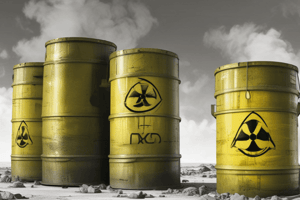Podcast
Questions and Answers
What should always be assumed about discovered military devices?
What should always be assumed about discovered military devices?
- They are likely souvenirs.
- They are inert.
- They are live. (correct)
- They can be handled without precautions.
Which of the following could indicate the presence of a mail bomb?
Which of the following could indicate the presence of a mail bomb?
- An envelope with a return address.
- A package that has too much postage. (correct)
- An envelope with a printed label.
- A package that is pre-stamped.
What is the primary characteristic of an improvised explosive device (IED)?
What is the primary characteristic of an improvised explosive device (IED)?
- It is a homemade bomb built for military use only.
- It is always made from military-grade materials.
- It is only used in conventional warfare.
- It can be disguised as almost anything. (correct)
What immediate action should be taken if a suspicious mailed item is found?
What immediate action should be taken if a suspicious mailed item is found?
Which of the following is NOT a common method of disguising IEDs?
Which of the following is NOT a common method of disguising IEDs?
What should you do if you encounter an abandoned military item?
What should you do if you encounter an abandoned military item?
Which of the following is a sign of a suspicious package?
Which of the following is a sign of a suspicious package?
What is one characteristic of Class 7 substances?
What is one characteristic of Class 7 substances?
Why is it important to treat any suspicious object as a possible explosive device?
Why is it important to treat any suspicious object as a possible explosive device?
Which of the following is classified as a Class 8 substance?
Which of the following is classified as a Class 8 substance?
In the context of hazmat incidents, what does 'occupancy' refer to?
In the context of hazmat incidents, what does 'occupancy' refer to?
What should you assume about a building if you do not know its occupancy type?
What should you assume about a building if you do not know its occupancy type?
What type of substances fall under Class 9?
What type of substances fall under Class 9?
Which factor may affect your response to a potential hazard?
Which factor may affect your response to a potential hazard?
What information can the shape of a container provide in a hazmat situation?
What information can the shape of a container provide in a hazmat situation?
Which of the following is an example of Class 9 materials?
Which of the following is an example of Class 9 materials?
What is the first step after isolating the immediate danger area?
What is the first step after isolating the immediate danger area?
What determines the protective action distance in a hazardous material incident?
What determines the protective action distance in a hazardous material incident?
Under what circumstances should an area be evacuated?
Under what circumstances should an area be evacuated?
What guideline is stated for awareness-level responders regarding fires involving hazardous materials?
What guideline is stated for awareness-level responders regarding fires involving hazardous materials?
What can increase the radius of danger in a hazardous material incident?
What can increase the radius of danger in a hazardous material incident?
What should operational-level personnel have to fight a fire involving hazardous materials?
What should operational-level personnel have to fight a fire involving hazardous materials?
Which factor is NOT mentioned as influencing the recommendations for protective action distances?
Which factor is NOT mentioned as influencing the recommendations for protective action distances?
What is a possible risk when evacuating from a hazardous incident?
What is a possible risk when evacuating from a hazardous incident?
What is a vehicle-borne improvised explosive device (VBIED)?
What is a vehicle-borne improvised explosive device (VBIED)?
Which of the following is NOT an indicator of a VBIED?
Which of the following is NOT an indicator of a VBIED?
What should you do if you suspect a vehicle could contain explosives?
What should you do if you suspect a vehicle could contain explosives?
Why is the evacuation distance from a vehicle greater than from a building in the case of a VBIED?
Why is the evacuation distance from a vehicle greater than from a building in the case of a VBIED?
What are the typical components of incendiary devices?
What are the typical components of incendiary devices?
Which method is commonly used to identify a VBIED?
Which method is commonly used to identify a VBIED?
Who typically uses incendiary devices?
Who typically uses incendiary devices?
What should be noted if a vehicle is suspected of being a VBIED?
What should be noted if a vehicle is suspected of being a VBIED?
What is the first step to conduct when performing an exterior search of a building?
What is the first step to conduct when performing an exterior search of a building?
During an interior search, what area should you prioritize?
During an interior search, what area should you prioritize?
Which search pattern should be avoided when searching for explosives?
Which search pattern should be avoided when searching for explosives?
What should you do before entering a doorway during a search?
What should you do before entering a doorway during a search?
How should search teams handle assigned areas of a building?
How should search teams handle assigned areas of a building?
Which of the following areas is NOT primarily a focus during a thorough exterior search?
Which of the following areas is NOT primarily a focus during a thorough exterior search?
What is a key precaution to take when searching for explosives?
What is a key precaution to take when searching for explosives?
What should be done if the public area search yields no results?
What should be done if the public area search yields no results?
What factors should be considered when assessing the credibility of a threat?
What factors should be considered when assessing the credibility of a threat?
What is the primary action required if a credible threat is perceived?
What is the primary action required if a credible threat is perceived?
Who must give permission to search or evacuate a building if a threat is identified?
Who must give permission to search or evacuate a building if a threat is identified?
What should be done when evidence of a threat takes physical form, such as a note?
What should be done when evidence of a threat takes physical form, such as a note?
How should potential suspects be identified when assessing a threat?
How should potential suspects be identified when assessing a threat?
Why should all threats and bomb situations be treated as credible initially?
Why should all threats and bomb situations be treated as credible initially?
Which method is critical for communicating in the event of a threat?
Which method is critical for communicating in the event of a threat?
What should you do if you encounter a suspicious item during a threat assessment?
What should you do if you encounter a suspicious item during a threat assessment?
When should you notify emergency services like the bomb squad?
When should you notify emergency services like the bomb squad?
What should be prioritized when gathering information about a threat?
What should be prioritized when gathering information about a threat?
Flashcards are hidden until you start studying
Study Notes
Classes of Hazardous Materials
- Class 7: Radioactive substances include nuclear waste and X-ray equipment.
- Class 8: Corrosive substances such as acids and solvents can cause irreversible damage to human tissues.
- Class 9: Miscellaneous dangerous goods not covered in Classes 1–8 include lithium-ion batteries, dry ice, magnetized metals, airbags, asbestos, and hazardous waste.
Occupancy and Location
- Occupancy indicates the use of a structure, such as manufacturing or retail spaces.
- Location encompasses areas like industrial parks and residential neighborhoods, affecting hazard response based on traffic and time of day.
Evacuation
- Evacuate the immediate danger area and downwind regions based on material type and incident specifics.
- Protective action distances vary depending on the hazardous material, spill size, and weather conditions.
- Follow agency policies during evacuation to prevent greater hazards, especially in populated areas or near critical facilities.
Emergency Response
- Fire Response: Non-trained personnel must not engage in firefighting during hazardous material incidents. Only operational-level responders with proper training and equipment should attempt defensive actions.
- Military Ordnance: Recognize devices like grenades and landmines, and assume they are live. Clear areas and contact bomb squads for removal.
Explosive Devices
- Improvised Explosive Devices (IEDs) are homemade bombs made from common materials, often concealed to avoid detection.
- Mail Bombs: Indicators include rigid packages, excessive postage, misspellings, and unusual odors. Isolate and evacuate if suspicious.
- Vehicle-Borne IEDs (VBIEDs): Powerful devices hidden in vehicles; indicators include suspicious parking and strange odors. Establish a large evacuation perimeter if suspected.
Incendiary Devices
- Incendiary Devices like Molotov cocktails can cause significant destruction. They include an ignition source, combustible material, and a container.
Searching for Devices
- Follow systematic search plans for potential explosive devices, starting from the exterior and moving indoors.
- Check high-risk areas first, such as entryways, restrooms, and utility rooms, and remain vigilant for booby traps.
- Use tape to mark searched areas and consider safety when entering spaces.
Evacuation Procedures
- Immediate danger area must be isolated before evacuating surrounding populations.
- Protective action distance varies based on hazardous material type, spill extent, and fire potential.
- Consult emergency response guides to determine safe distances for evacuation.
- Extended incidents with fire or explosion risk warrant immediate evacuation.
- Hazard assessments consider geographic and weather conditions affecting material distribution.
Emergency Response
- Divides into three critical subsections: fire response, spill or leak management, and first aid.
- Awareness-level responders are restricted from extinguishing fires with hazardous materials due to insufficient training.
- Only operational-level personnel with appropriate training and resources can conduct defensive fire attacks.
- After-action analysis focuses on identifying weaknesses and enhancing training for responders.
Methamphetamine Laboratories (Meth Labs)
- Meth labs range from small, covert setups to large-scale operations.
- Manufacturing typically involves pseudoephedrine or ephedrine and numerous common household chemicals.
- Key materials indicating a meth lab include coffee filters, two-liter bottles, lithium batteries, and drain cleaner.
- Chemical odors linked to meth labs may include characteristics resembling rotten eggs.
- Dead vegetation is often found surrounding these sites, indicating chemical contamination.
Chemical Suicide Indicators
- Establish a safe perimeter around potential chemical suicide scenes; do not allow public entry.
- Signs for caution include unresponsive individuals in vehicles, taped warning signs, and the presence of unusual odors.
- Resuscitation efforts are discouraged if specific indicators are present, such as suicide notes or chemical residue.
- Symptoms of chemical exposure range from mild irritation to severe respiratory issues and potentially fatal outcomes.
Explosive Devices Awareness
- Recognize that various types of explosive devices exist; not all can be identified by responders.
- Essential to gather information including threat nature, suspected detonation time, and device descriptions.
- Evacuating at least 30 minutes before an alleged detonation enhances safety.
- Location knowledge aids in planning appropriate responses and communication during threats.
Threat Credibility Assessment
- Collect detailed information regarding the threat, including witness statements and previous incidents.
- Surveillance footage can prove crucial in establishing threat credibility.
- Treat all bomb threats as credible until explicitly proven otherwise; immediate safety measures should be prioritized.
- Mandatory evacuation orders are enacted upon discovery of explosive devices; gather evidence from any physical threat forms.
Studying That Suits You
Use AI to generate personalized quizzes and flashcards to suit your learning preferences.





